IK Level Tester
LED Optical Aging Test Instrument
MOQ :1 piece
Lead Time :15 Days
Seller Support : Trade Authenticity Guaranteed & Accepting
Payment : L/C,T/T,Western Union, Money Gram, Credit Card, Paypal
Product details
Supply Ability
- Supply Ability:10 piecesWarranty(Year):1 Year
Packaging & Delivery
- Length:100 cmWidth:100 cm
- Height:150 cm
- Packaging:1 piece
Product Specifications
Product Description
The LED Optical Maintance and Life Test System (LEDLM-80PL) is according to IES LM-79, IES LM-80, IES LM-82, TM-12, GB2312-80, CIE and IEC Standards.
Refer to LM-80, the LED typically exhibit very long operational life characteristics and, depending on drive current and use conditions, can be in use for 50,000 hours or longer. Like all light sources, the light output from LED slowly decreases in output over time. Unlike traditional light sources, LED does not tend to fail catastrophically. Therefore, over time, lumen maintenance can result in lower light output than intended in the specification or required by codes, standard practices or regulations.
System Principle
Rated Lumen Maintenance Life, the elapsed operating time over which the LED light source will maintain the percentage, p, of its initial light output e.g:
?L70 (hours): Time to 70% lumen maintenance
?L50 (hours): Time to 50% lumen maintenance
The LED life is predicted according to the Arrhenius model, the formula as following:
1. P=P0 exp(-βt)
2. β=β0 IFexp(-Ea/KTj)
Note: P0 is initial lumen; P is lumen under heat and electricity; β is recession coefficient in a certain temperature; t is the time to electricity in a certain temperature; β0 is constant value; Ea is activation energy; K is Boltzmann's constant; IF is working current; Tj is junction temperature.
Firstly, we predict the LED life per 10000hours.
For example, we suppose the optical decay rate is n% in 1000hours, then:
Base on formula 1, L50 is: t=1000*ln0.5/ln(1-n%)
Base on formula 1, L30 is: t=1000*ln0.7/ln(1-n%)
So we can get:
| Item | Optical decay rate | L50(h) | L30(h) |
| 85°C | 8% | 8312.950414 | 4277.62127 |
| 70°C | 3% | 22756.57306 | 11709.922 |
The temperature Tj (the contact surface temperature between LED and circuit board, or ambient temperature providing the heat-sink is complete, but the junction temperature will be 15°C higher than ambient temperature in 350mA) will greatly affect the test result. We can predict the LED life under varies temperature according to formula 2. Suppose the time t1 is the LED life under T1 temperature, time t2 is the LED life under T2 temperature, then we can calculate the time t3 under T3 temperature:
t3=t1*exp{(ln(t2/t1)/[1/(T2+15+273)-1/(T1+15+273)] * [1/(T3+15+273)-1/(T1+15+273)]}
Then we can get the time to 50% and 30% lumen maintenance under different temperature:
| Item | Tj=85°C (h) | Tj =70°C (h) | Tj =50°C(h) | Tj =25°C(h) |
| L50 | 8312.950414 | 22756.57306 | 100144.3113 | 833055.6622 |
| L30 | 4277.62127 | 11709.922 | 51531.576 | 428668.0953 |
Optical decay trend can be showed as the following curve:
You May Like
- Free Member
- Trade Assurance
Business Type : Manufacturer,Exporter
Company Location:
Year Established: 21YRS














